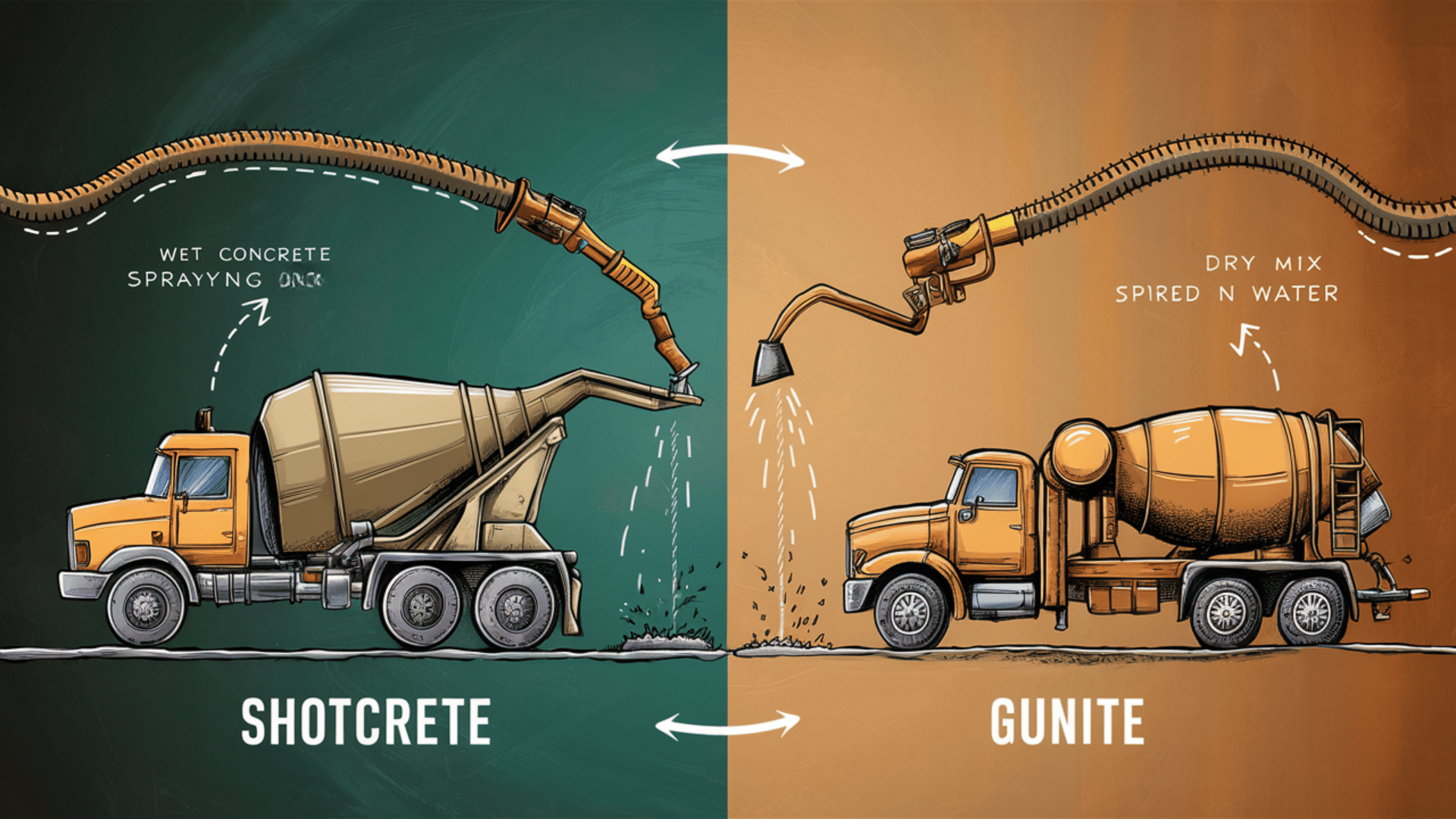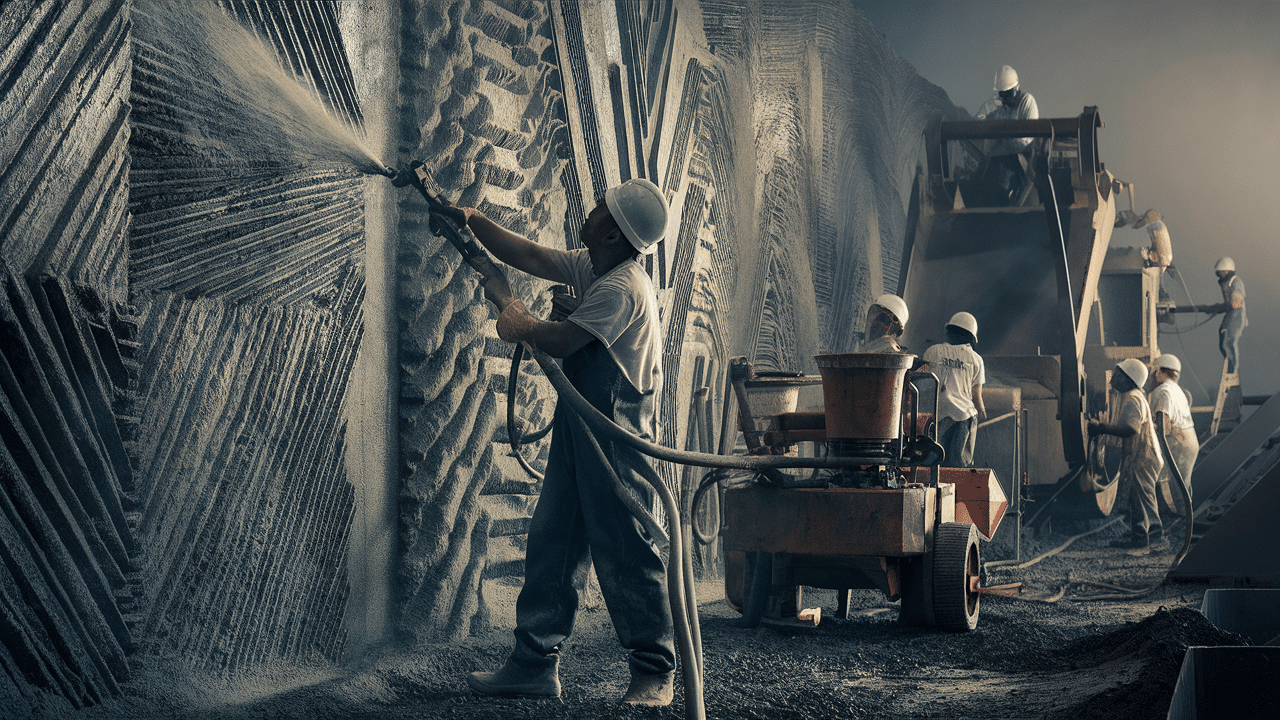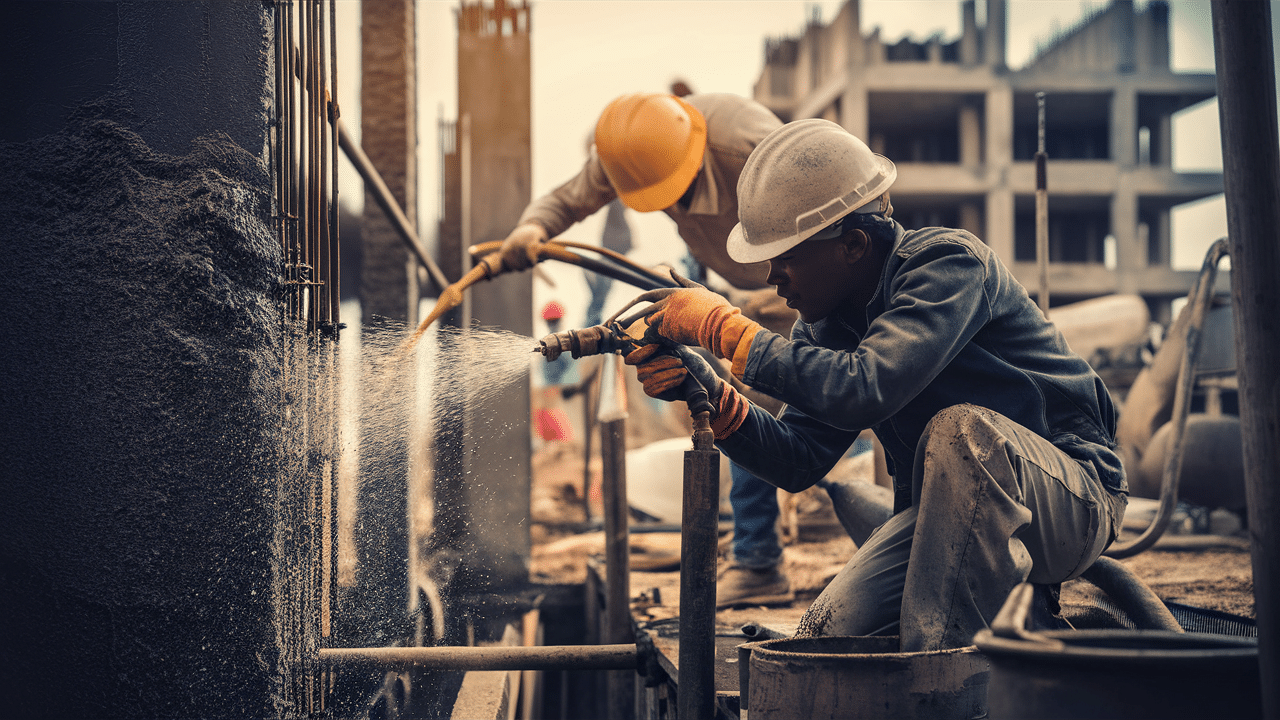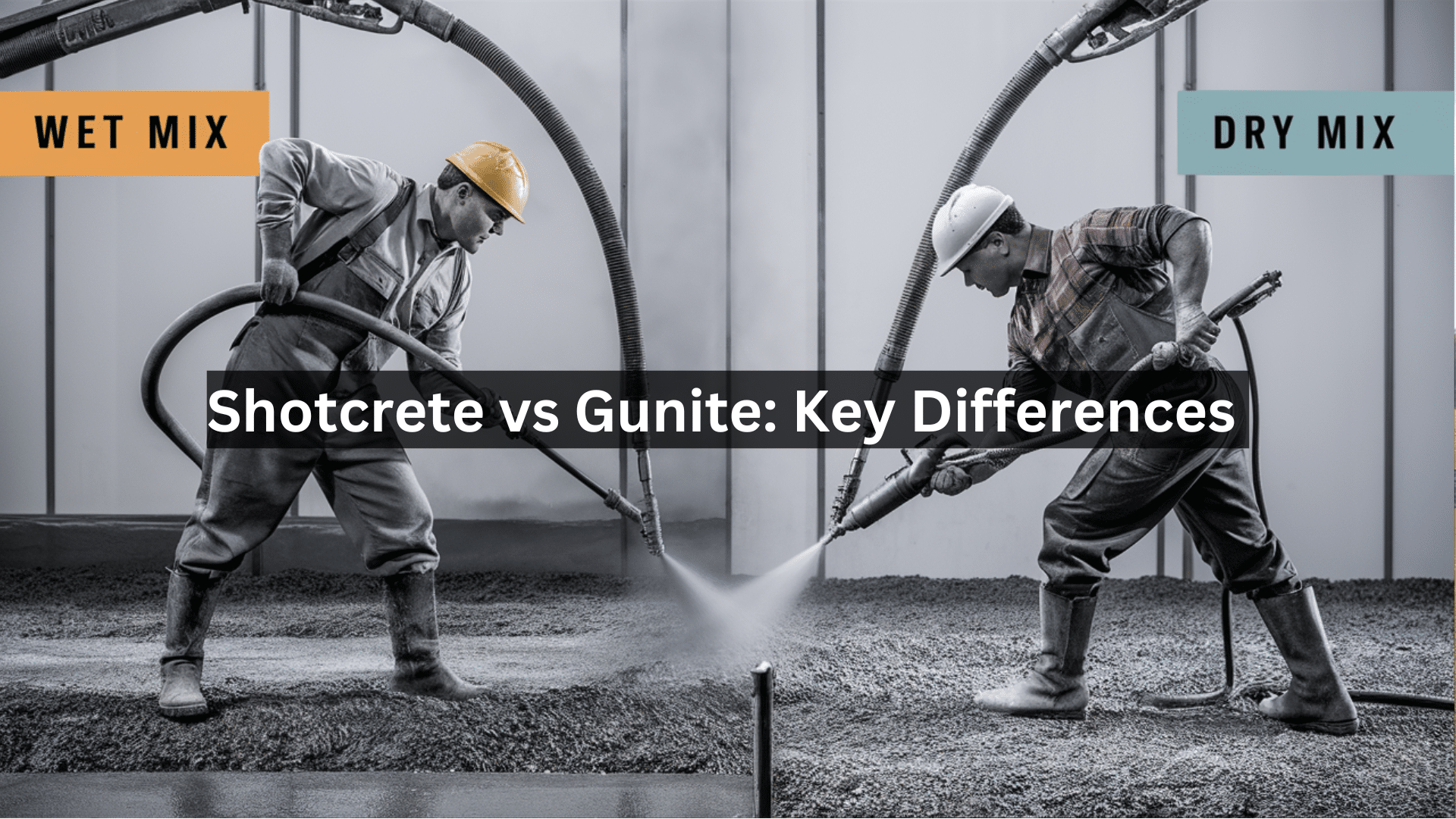Are you trying to figure out whether to use shotcrete or gunite for your construction project? I understand how confusing these terms can be.
In this article, I’ll explain the key differences between shotcrete and gunite, their application methods, costs, and ideal uses. You’ll learn exactly when to choose each option based on your specific needs.
By the end of this guide, you’ll be able to make a confident decision that will save you time, money, and stress. No more second-guessing your material choice – I’ll help you get it right the first time.
What Are Shotcrete and Gunite?

Shotcrete is a method where ready-mixed concrete is pumped through a hose and sprayed onto a surface at high speed. The mix already contains water when it’s loaded into the equipment. This wet-mix system first appeared in the 1950s and has become increasingly popular for large-scale projects.
Gunite, on the other hand, is a process where a dry mix of sand and cement is fed through a hose, with water added at the nozzle just before it’s sprayed onto the surface. The term “gunite” was trademarked in 1911 and was the original spray concrete method before shotcrete was developed.
The main difference? Shotcrete is wet-mixed before application, while gunite combines dry materials with water right at the point of application. This affects everything from how they’re used to their final results.
Both materials can contain similar ingredients: cement, sand, and sometimes small aggregates or fibers for added strength. However, shotcrete can accommodate larger aggregate sizes (up to 3/4 inch) compared to gunite (typically limited to 3/8 inch or less). This difference in aggregate size affects the final texture and application properties of each material.
Standard mixes often include:
- Portland cement (the binding agent)
- Graded sand (for body and texture)
- Small aggregates (for strength)
- Optional additives (for water resistance, flexibility, or faster setting)
Each mix can be customized based on your project’s specific requirements for strength, setting time, and durability.
The Process Of Application
Shotcrete Application

- The concrete arrives pre-mixed with water from a plant
- Material is pumped through a hose to the nozzle
- A crew member directs the nozzle to spray the wet mix onto the surface
- Another crew member may smooth and shape the applied material
Gunite Application

- A dry mix of sand and cement is loaded into a hopper
- Compressed air forces the mix through the delivery hose
- Water is added at the nozzle, combining with the dry mix
- The operator controls both the mix and water ratio while spraying
Equipment Used
For shotcrete: Concrete pumps, wet-mix shotcrete machines, and delivery hoses with specialized nozzles.
For gunite: Dry-mix guns, air compressors, and hoses with special water-ring nozzles.
Shotcrete is better for larger projects because it can be applied faster and in greater volume. Gunite gives better control over the water content and is better for detailed or smaller jobs.
Strength and Durability: Which One Lasts Longer?
When it comes to strength and durability, both materials perform well but have different characteristics:
| Feature | Shotcrete | Gunite |
|---|---|---|
| Typical strength | 4,000-5,000 PSI | 5,000+ PSI with proper mixing |
| Consistency | More uniform due to plant mixing | Varies based on the nozzleman’s skill |
| Layer bonding | Stronger bond between layers | May have better bonding in overhead applications |
| Slump resistance | May slump slightly on vertical surfaces | Better for vertical applications with less slump |
| Weak spots | Less likely due to consistent mixing | Depends heavily on operator skill |
| Precision | Less control for thin applications | Superior for thin, detailed applications |
| Expected lifespan | 50+ years with proper installation | 50+ years with proper installation |
| Freeze-thaw resistance | Good with proper air entrainment | Good with proper air entrainment |
The key factor in durability isn’t just the material but the skill of the application team. Both can last 50+ years when properly installed and maintained. In my experience, shotcrete might have a slight edge for large structural applications, while gunite often works better for pools and detailed work.
Factors Affecting Longevity
Several important factors determine how long either material will last:
- Proper curing: Both shotcrete and gunite need adequate moisture during the curing process. This usually means keeping the surface damp for 5-7 days after application.
- Reinforcement: The addition of rebar, welded wire mesh, or fibers significantly improves long-term durability.
- Weather conditions: Extreme temperatures during application can affect final strength. The ideal application temperature is between 50-85°F (10 and 29°C).
- Maintenance: Regular inspection and prompt repair of cracks can extend the lifespan by decades.
Real-world performance: In my construction projects, I’ve seen both materials perform exceptionally well over time. A shotcrete retaining wall I worked on 20 years ago still shows no signs of structural issues, while a gunite pool shell from 15 years ago remains perfectly intact despite numerous freeze-thaw cycles.
Cost and Convenience: What’s More Affordable?
I’ve found that cost comparisons depend on your specific project:
Shotcrete costs:
- Higher equipment costs
- Lower labor costs (faster application)
- Better for large projects due to economies of scale
- Average cost: Approx. $125-175 per cubic yard applied
Gunite costs:
- Lower equipment costs
- Higher labor costs (more skill required)
- Better for smaller projects
- Average cost: Approx. $150-200 per cubic yard applied
Shotcrete usually saves money on large projects because it is faster to apply. For smaller jobs, gunite might be more cost-effective because it requires less expensive equipment and allows for on-site adjustments.
Ideal Applications: When to Choose Shotcrete, When to Choose Gunite
| Project Type | Better Choice | Why? |
|---|---|---|
| Large structural walls | Shotcrete | Faster application, better for high volume |
| Swimming pools | Gunite | Better control for custom shapes and details |
| Tunnel supports | Shotcrete | Consistent application in difficult spaces |
| Detailed architectural features | Gunite | Precise water-to-cement ratio control |
| Highway/bridge repairs | Shotcrete | Speed and efficiency for large areas |
| Historic restoration | Gunite | Better for recreating fine details |
| Mining support | Shotcrete | Rapid application in challenging environments |
| Sculptures/decorative elements | Gunite | Superior control for artistic details |
| Projects with dense reinforcement | Shotcrete | Better flow around complex rebar arrangements |
| Areas with limited water supply | Gunite | More efficient water usage at point of application |
Environmental and Sustainability Factors
Both methods have environmental impacts to consider:
Shotcrete environmental factors:
- Less waste at the application site
- More energy is used in transport (heavier wet mix)
- Less dust during application
- Higher water usage in the mixing process
- Lower carbon footprint per square foot for large projects
Gunite environmental factors:
- Potentially more material waste
- Less transport energy (lighter dry mix)
- More dust during application (requires better safety measures)
- Better control over water usage at the point of application
- Less concrete waste if the project requires frequent stops and starts
Eco-Friendly Options
The concrete industry has made significant progress in developing more sustainable options:
Green alternatives for both methods:
- Mixes containing fly ash (a byproduct from coal power plants)
- Silica fume additions (waste from silicon production)
- Ground granulated blast-furnace slag (byproduct from steel manufacturing)
- Carbon-capturing concrete technologies
These alternative ingredients reduce the environmental impact and can improve the performance characteristics of the finished product. For example, fly ash can make concrete more workable and reduce permeability.
To reduce the environmental impact of either method, I recommend:
- Using mixes with recycled materials when possible
- Planning carefully to minimize waste
- Choosing local suppliers to reduce transportation emissions
- Selecting contractors who follow dust-control best practices
- Considering rainwater collection systems for curing water
Water conservation: One project I worked on used a closed-loop water system for curing, which recycled over 80% of the water usually needed. This approach saved thousands of gallons while maintaining excellent curing conditions.
Conclusion
The choice between shotcrete and gunite isn’t one-size-fits-all. After testing both methods for years, I can tell you that your project needs should guide your decision. Choose shotcrete when speed and volume matter – it’s perfect for large walls and commercial work. Pick gunite when precision counts – it shines for custom pools and detailed features. Both methods can last for decades when done right.
What matters most? The skill of your contractor. A well-applied gunite finish will outperform poorly applied shotcrete every time. Focus on finding contractors with specific experience in your chosen method.
Armed with this knowledge, you can confidently make a smart choice between shotcrete and gunite for your next project.
Frequently Asked Questions
What’s the Main Difference Between Shotcrete and Gunite?
Shotcrete uses a pre-mixed wet concrete that’s pumped through a hose. Gunite uses a dry mix where water is added at the nozzle during application.
Which Method Is More Cost-Effective?
Shotcrete is usually cheaper for large projects due to its faster application. Gunite may be more cost-effective for smaller, detailed projects that require precision.
Can Shotcrete and Gunite Be Used for Vertical Surfaces?
Yes, both are excellent for vertical applications. Their high-velocity application creates a strong bond to properly prepared surfaces without the need for forms.
How Soon Can Shotcrete or Gunite Surfaces Be Used After Application?
The initial set occurs within hours, but full curing takes 28 days. Most projects can handle light use after 7 days, though pools shouldn’t be filled until fully cured.
Do Shotcrete and Gunite Require Special Maintenance?
Both require similar maintenance to regular concrete. Periodic sealing every 3-5 years helps prevent water penetration and extends their service life.

